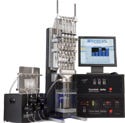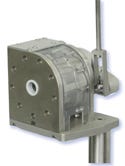Testing and Inspection 15630
Wireless data collected directly from patients during normal physical activities could enable the development of better knee implants
January 14, 2008
Originally Published MPMN January/February 2008
FOCUS ON EQUIPMENT
Testing and Inspection
Equipment Evaluates Particulate Loss of Coated Devices
|
Simulating particulate loss that can occur when coated medical devices are inserted into the vascular system, a testing machine detects the size and number of particles being shed. The company’s coating durability tester can evaluate multiple coated and drug-eluting stent samples for particulate loss simultaneously. Real-time particle counting is enabled by the system’s unidirectional flow process that sends the prefiltered testing solution through the test samples and the inline laser particle counters. An electromagnetic motor produces adjustable bellows compression at rates up to 150 Hz. Testing speed, stent deflection, and sample pressures can be adjusted.
Dynatek Dalta, Galena, MO
www.dynatekdalta.com
Contour Measurement Tool Checks for Deviations from Device Design
|
Using a moving stylus, a contour measurement instrument captures form and profile data. The Contracer CBH-400 can verify the geometry of device components such as a volute in a heart pump. Analyzing the contoured shape and surface finish of a device’s inner components, like volutes and tubing, can be critical to the device’s flow performance. Measured profile geometry is overlaid on a CAD model to check for deviations from the device’s design. The tool can amplify measurements as it creates a profile trace, allowing designers to increase the accuracy of their data. Data are processed using the manufacturer’s Formpak software, which enables the measurement tool to obtain contour readouts on all curved surfaces at any magnification up to 200%.
Mitutoyo America Corp., Aurora, IL
www.mitutoyo.com
Radial Compression Tool Mounts on Existing Tensile Testing Machines
|
A radial compression mechanism can be mounted directly onto common tensile testing equipment using an adapter kit. When used with a tensile testing machine, the J-Crimp device can control and vary the diameter of a cylindrical object, such as a stent, and measure the radially outward force of the object. The tool has friction levels lower than typical stent radial forces and allows users to measure small differences between product designs and samples. The adapter includes a force-limiting clip that prevents accidental damage to the compression station.
Blockwise Engineering LLC, Phoenix, AZ
www.blockwise.com
Benchtop Electropneumatic System Performs Leak and Obstruction Tests
|
Elastic and rigid medical devices can be subjected to air-pressure decay, leak, and obstruction testing using a benchtop electropneumatic tool. The P-Test series tool performs three types of tests: a leak test that analyzes pressure decay and the leak rate, a single-obstruction test, and a multiple-obstruction test. Performing routine tests in production lines, product validation, and quality assurance tests, the tool offers a range of pressures and test times for application-specific testing and high accuracy.
TechnoMed Inc., Wallace, NC
www.technomedinc.com
Automated Inspection System Uses Telecentric Lenses to Review Parts
|
An automated inspection system features a six-axis robot that picks up medical device parts individually and positions them in front of two high-resolution cameras with telecentric lenses. Multiple dimensions of the parts are captured using Cognex Visio Pro tools and custom software and are then used to determine whether the part is accepted or rejected. Typical inspection time of each part is less than 1 second, depending on the number of dimensions to be measured. Parts enter the machine on trays of 25 to 100. The system is designed to inspect components of medical devices and implants, such as connectors, screws, and hooks.
DWFritz Automation Inc., Portland, OR
www.dwfritz.com
Electrical Test Sets Feature Custom Voltage Control Options
|
Electrical test sets enable manufacturers to monitor and control a range of variables while testing medical equipment, electrical motors, compressors, power supplies, and more. The Power Provider systems test variables such as accelerated service life, start-up and run-down efficiency, and capacity. The test sets can be customized based on a customer’s testing procedures, data to be acquired, and purpose for acquiring the data. Optional features include use of an output autotransformer with taps that controls the voltage drop from no-load to full-load, an output controller that maintains the voltage to ±0.5 V, and an RS-232 interface for downloading data into a computer system.
Staco Energy Products Co., Dayton, OH
www.stacoenergy.com
Parts Cleanliness Testing Station Reduces the Risk of Patient Infection
|
By rapidly measuring particle levels on medical device parts, a testing station evaluates component cleanliness to reduce the risk of patient infection or rejection. The Surfex measures part cleanliness after the normal cleaning process is complete. Combining ultrasonic extraction, high-sensitivity optical particle measurements, and automated software control, the machine quantifies surface cleanliness. It also reduces cleanliness testing costs associated with manual methods, such as microscopy and filtering, by increasing sample throughput, according to the manufacturer. A variety of particle counter sensitivities and ultrasonic frequencies can be programmed into the machine to customize testing for specific applications.
Particle Measuring Systems, Boulder, CO
www.pmeasuring.com
Copyright ©2008 Medical Product Manufacturing News
You May Also Like








.png?width=300&auto=webp&quality=80&disable=upscale)
